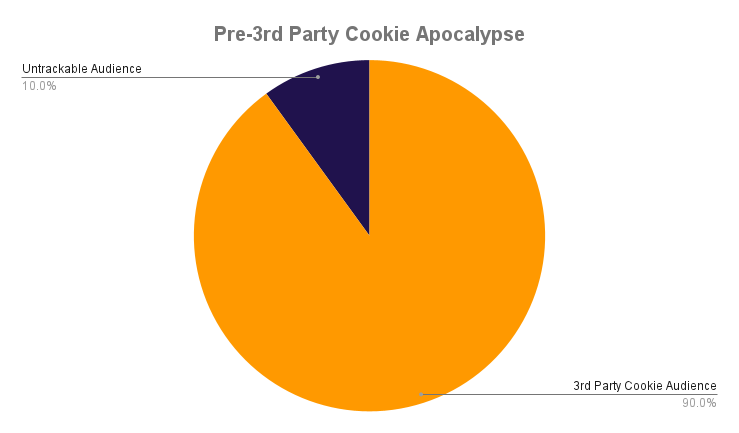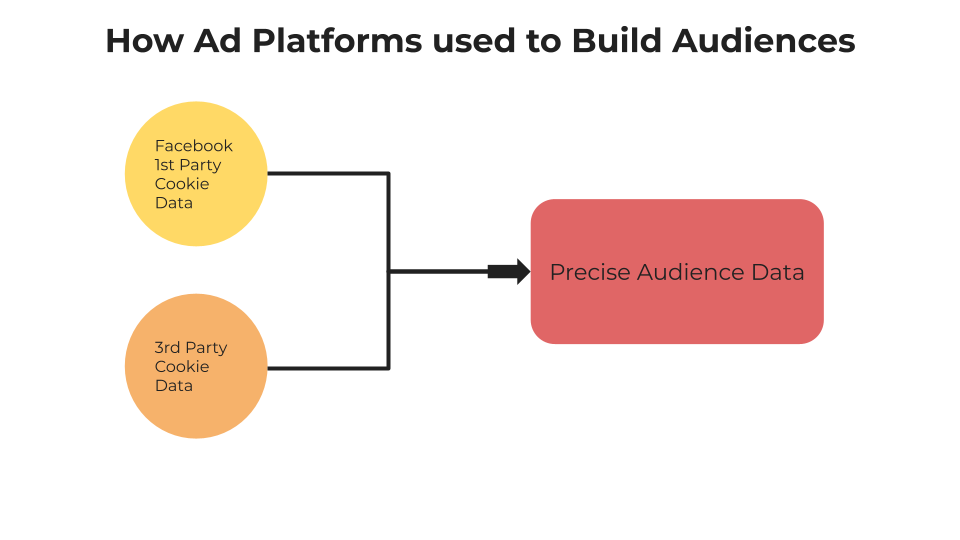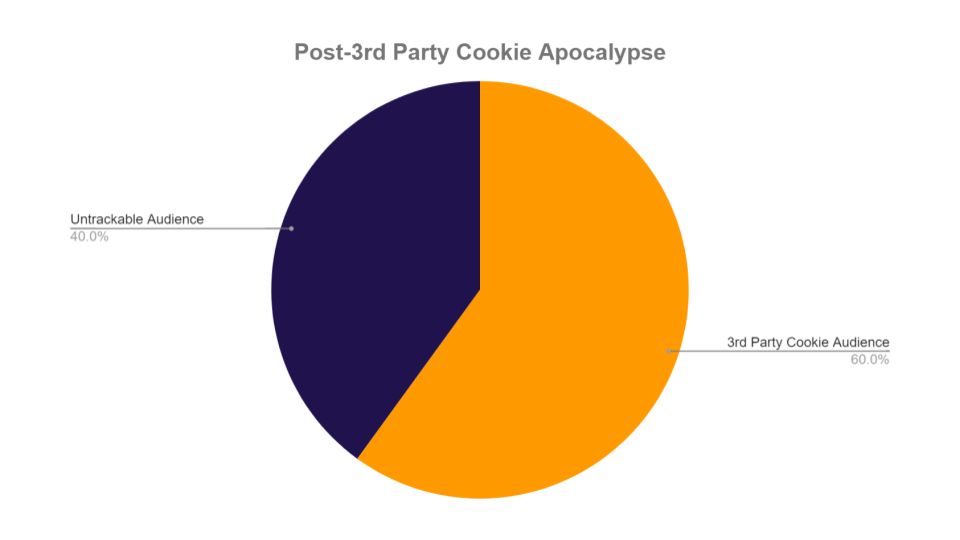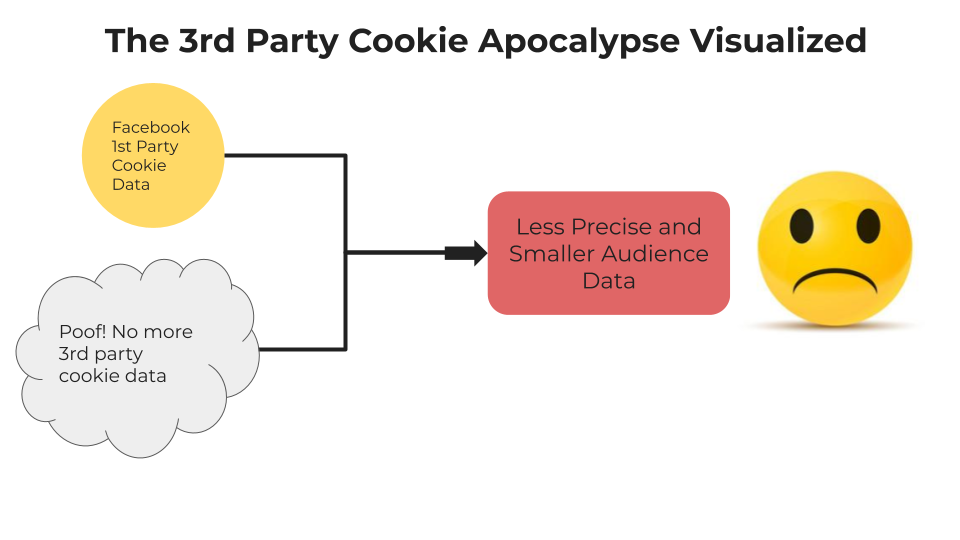The Past 3 Years Have Been Tough for Digital Ads.
How Did We Get Here?
The goal of this article is to explain, in straightforward terms, why your digital ads have become more expensive and less effective over the last 3 years.
Then, we want to show you what you can do to combat it.
First things first, rough definitions:
There are two things things we need to define before we get into this article.
Note, these are not technical definitions, just definitions that serve to explain what’s going on.
First party cookies: code that helps a website track users as they navigate and interact with the site.
They are run by the business/website itself.
These are essential for websites to function – they enable your site to remember what items someone has put in a shopping cart from your store for example.
They are very rarely blocked because of this.
Third party cookies: code that tracks users as they move across the internet – across many different sites.
They are often run by a third party (surprise, surprise!).
These are non-essential, but are great for tracking users as they move across websites whilst browsing.
What used to happen with Digital Ads
We’re going to illustrate our point using Facebook, but this can equally apply to other ad platforms.
When you advertise with Facebook, they have(or had depending on when you read this article) you place two tags on your website.
The Facebook 1st party tag – this tracks clicks and conversions from Facebook to your site.
The Facebook 3rd party tag – this tracks user IDs across the internet.
Facebook combines data from both tags in order to effectively track ad performance, to build profiles of customers and to create audiences, retargeting etc.
As they have such a huge user base, this tracking covered a massive portion of internet users. It gave them incredibly detailed profiles and relatively accurate journey data for ad performance. This is what led them to make so much money from advertising. They were able to give you huge, well targeted audiences to market to and then show you that the conversions were working well.
There was always a minority of internet users who were very privacy conscious. These people used a variety of strategies to prevent themselves being tracked, but they made up at most 10% of the users of the internet. This meant that the remaining 90% or so were easy to follow.

The Story of Jane
The above is all still quite theoretical, so here is a story of how this worked in real life.
Jane loves running. She has the Facebook app and Nike Running app on her phone which is an Android model. The Nike app is using Facebook’s SDK (software development kit), which is often used alongside Google’s SDKs to track ad performance and/or build retargeting audiences.
Facebook knows Jane because she uses the Facebook app, and then they collect the same device ID from her Nike app. They connect the dots and put Jane in a category of “Running Enthusiast” segment.
Now, if a running gear company is looking to advertise on Facebook to the specific people who are “running enthusiasts”, Facebook will include Jane’s profile in that list and she would see the ad from that running gear company.
The same thing happens on the web when using a desktop/laptop as well.
Then, Jane upgrades to an iPhone with iOS 14+. It automatically blocks Facebook from tracking her on other apps. So Facebook will have no idea that she a Nike Running app user, and will not be able to put her in that segment; thus reducing the number of people in the targetable “running enthusiast” audience.
On top of this, Facebook’s first-party cookies get blocked by many ad blockers and because people often jump between using their phone, PC or tablet, Facebook’s ability to connect the dots for accurate ad performance measurement is reduced. This has forced them to resort to using modeled performance reporting in many cases.

So what went wrong for Facebook? (and many other ad platforms too…)
In short: Apple introduced the iOS 14 update, the 3rd party cookie apocalypse began and general privacy concerns upended a host of established practices.
There’s a lot to talk about with all of these issues and we could write multiple blog posts on each of them.
The important thing to understand is that Apple stopped many of these companies from effectively tracking their customers. All of these changes were going to happen eventually, but Apple jumped in early and gained a huge advantage over its competitors.
When the dust settled, most ad platform audiences now looked like this:

What did this Apple update do?
- Apple started blocking 3rd party cookies as standard on its operating systems. Many ad blockers also did this, alongside other browsers like Firefox and a few others.
- Apple also blocked apps from tracking/interacting with other apps without permission from the user as standard. Previously, apps could communicate without many restrictions – see the Story of Jane for an example of this in action.
- Google also moved to stop the use of 3rd party cookies over time (though this process is still ongoing as of April 2023).
- Facebook’s 1st party pixel gets blocked regularly by ad blockers, and others as it is so ubiquitous and is not “essential” for websites. This is also the case for many other big advertising platform tags.

How did this change the business landscape?
What this did was to decrease the effectiveness of major platform’s advertising. They are now unable to give such large and precise audiences. This has increased costs for businesses who use them as they have to pay more to gain the reach they would have had before this update.
Facebook and others took a big hit to their share prices due to the loss of revenue from ads.
Facebook still has a massive audience – over 2 billion people use the platform – so it is far from a dead company.
They can still track ad clicks from their own users (this is their 1st party data when someone clicks a link on their site). However, they blind after that in many cases.
Ad platforms are now missing at least half of the equation that allowed them to create precise audiences – the 3rd party cookies.
It has also unsurprisingly led to Apple pushing into the ad platform business. Now that they have control of the data (all those iOS users are still visiting using the internet!), they promise that they have a more ethical way of targeting ads.
So what does this mean for you?
Your ad costs have gone up.
Your ad performance has decreased (ROI, ROAS, MER etc)
You have smaller audiences.
Much pain and suffering.
What can you do?
That’s in our next article.



